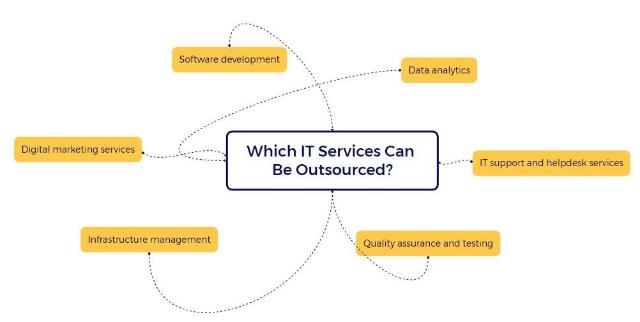How to Calculate ROI from IT Outsourcing: A Practical Guide
In today's competitive business landscape, IT outsourcing partnerships have become a popular strategy for companies looking to optimize their operations and reduce costs. However, to ensure that such partnerships deliver real value, it's crucial to calculate the Return on Investment (ROI) accurately. This guide will walk you through calculating the return on investment for IT services, providing practical steps and insights to help you make informed decisions about IT outsourcing costs.
Understanding ROI in IT Outsourcing Costs
ROI is a performance measure used to evaluate the efficiency of an investment. In the context of IT services, it helps determine whether the benefits outweigh the costs. The basic formula for calculating return is:
ROI = (Net Benefit / Cost of Investment) x 100%
However, calculating the return for IT services involves more complex considerations due to the nature of IT and the various factors that can impact costs and benefits.
Steps to Calculate Return on Investment from IT Outsourcing Services
Identify All Costs First, you must account for all IT outsourcing costs associated with the project. These may include:
- Partner fees
- Transition costs
- Management overhead
- Training expenses
- Technology and infrastructure costs
- Legal and compliance costs
Determine Potential Savings Next, estimate the potential savings from the partnership. Consider:
- Reduced labor costs
- Lower infrastructure expenses
- Improved efficiency and productivity
- Access to specialized skills and technologies
Quantify Intangible Benefits Some benefits may be more complex but still important. These can include:
- Increased focus on core business activities
- Improved quality of service
- Enhanced scalability and flexibility
- Access to global talent pools
Calculate the Net Benefit and Subtract the total IT costs from the total benefits (including both tangible savings and estimated value of intangible benefits) to determine the net benefit.
Apply the ROI Formula, use the net benefit figure and the total investment cost in the formula mentioned earlier.
Consider the Time Frame. The return can vary significantly depending on the time frame considered. Calculate short-term and long-term returns to view IT outsourcing costs and benefits comprehensively.
Example Calculation
Let's look at a hypothetical example to illustrate the process:
Company X is considering partnering for its IT support functions. Here's a breakdown of the costs and benefits over three years:
Costs:
- Partner fees: $500,000
- Transition costs: $100,000
- Management overhead: $50,000 Total Cost: $650,000
Benefits:
- Labor cost savings: $800,000
- Infrastructure savings: $200,000
- Estimated value of improved efficiency: $100,000 Total Benefit: $1,100,000
Net Benefit = $1,100,000 - $650,000 = $450,000
ROI = ($450,000 / $650,000) x 100% = 69.23%
In this example, the return of 69.23% over three years indicates a positive outcome on the IT outsourcing costs.
Statistical Data on IT Services Returns
To provide context, let's look at some industry statistics related to IT services returns:
|
Metric |
Percentage |
|
Average cost reduction from IT partnerships |
15-25% |
|
Companies reporting improved efficiency |
78% |
|
Businesses achieving investment goals |
82% |
|
Firms experiencing increased scalability |
65% |
|
Organizations reporting access to better technology |
70% |
Factors Affecting Return on Investment in IT Outsourcing Services
Several factors can impact the return of your IT initiative:
- Partner Selection: Choosing the right IT partner is crucial. A vendor with the right expertise and cultural fit can significantly enhance returns.
- Scope Definition: Clearly defining the scope of services helps avoid scope creep and unexpected IT outsourcing costs.
- Contract Terms: Favorable contract terms, including performance metrics and service level agreements (SLAs), can protect your investment.
- Transition Management: Effective management of the transition phase can minimize disruptions and associated costs.
- Ongoing Relationship Management: Regular communication and performance reviews with your IT partner can help maintain and improve returns over time.
- Technology Alignment: Ensuring the solution aligns with your existing technology stack can prevent integration issues and maximize efficiency gains.
- Scalability: The ability to scale services up or down based on business needs can significantly impact long-term returns.
Best Practices for Maximizing Returns in IT Services
To ensure you achieve the best possible outcome from your IT efforts, consider these best practices:
- Set Clear Objectives: Define what success looks like for your initiative before you begin.
- Conduct Thorough Due Diligence: Research potential partners carefully, considering factors beyond IT outsourcing costs.
- Start Small: Consider piloting with a smaller project before committing to large-scale partnerships.
- Invest in Relationship Building: Foster a strong partnership through open communication and collaboration.
- Implement Robust Governance: Establish transparent processes for managing the relationship and measuring performance.
- Continuously Monitor and Evaluate: Regularly assess the performance and value delivered by your IT arrangement.
- Be Prepared to Adapt: Be willing to change your strategy if it's not providing the expected returns.
Conclusion
Calculating the return on investment from IT services is a complex but essential process for ensuring that your strategy delivers real value to your business. By following this practical guide and considering the various factors that can impact returns, you'll be better equipped to make informed decisions about your IT initiatives and associated costs.
Remember that measuring return is not a one-time calculation but an ongoing process. Regularly reassessing your IT outsourcing services performance can help you identify areas for improvement and ensure that your strategy continues to align with your business objectives in the long term.

